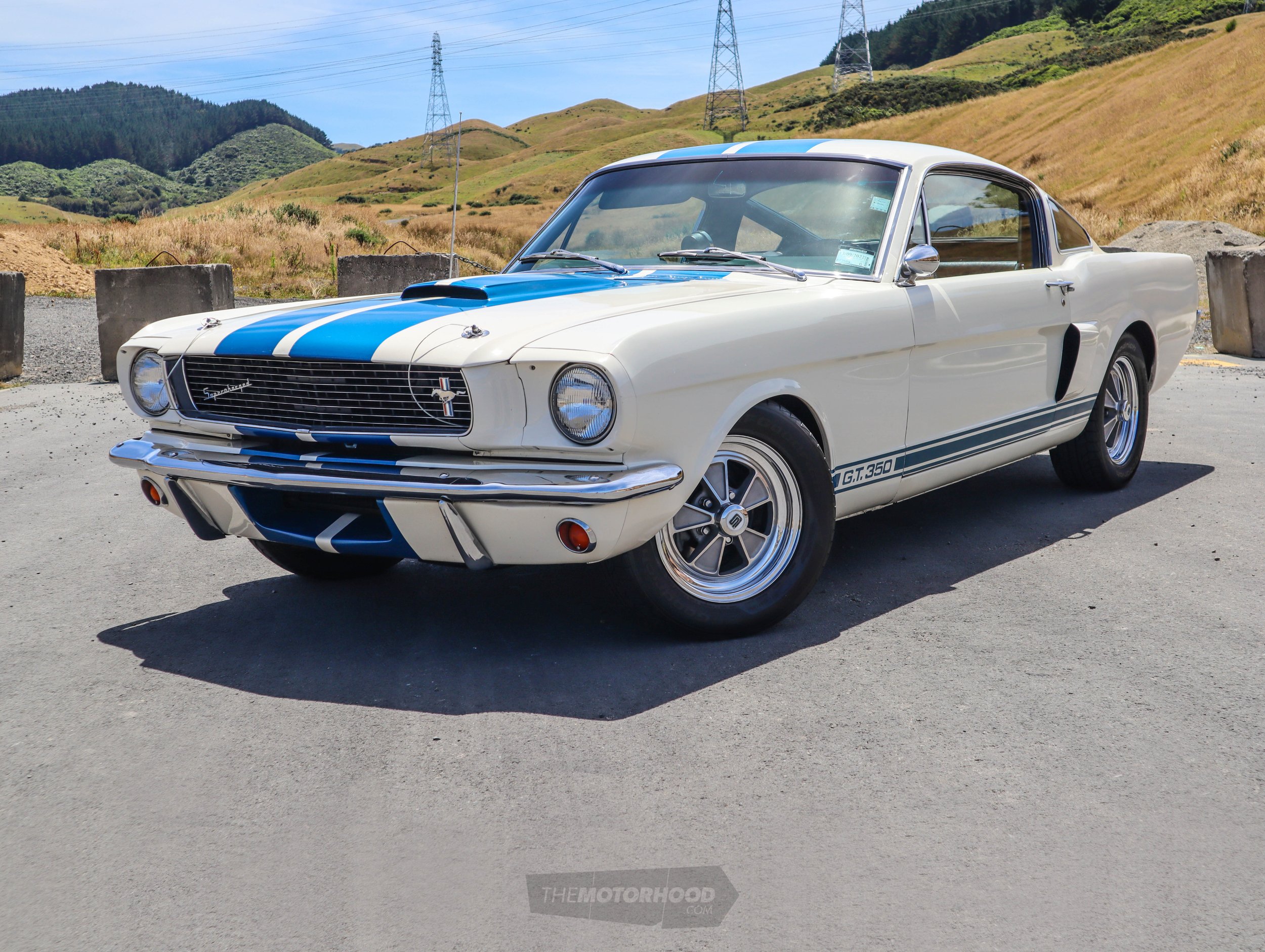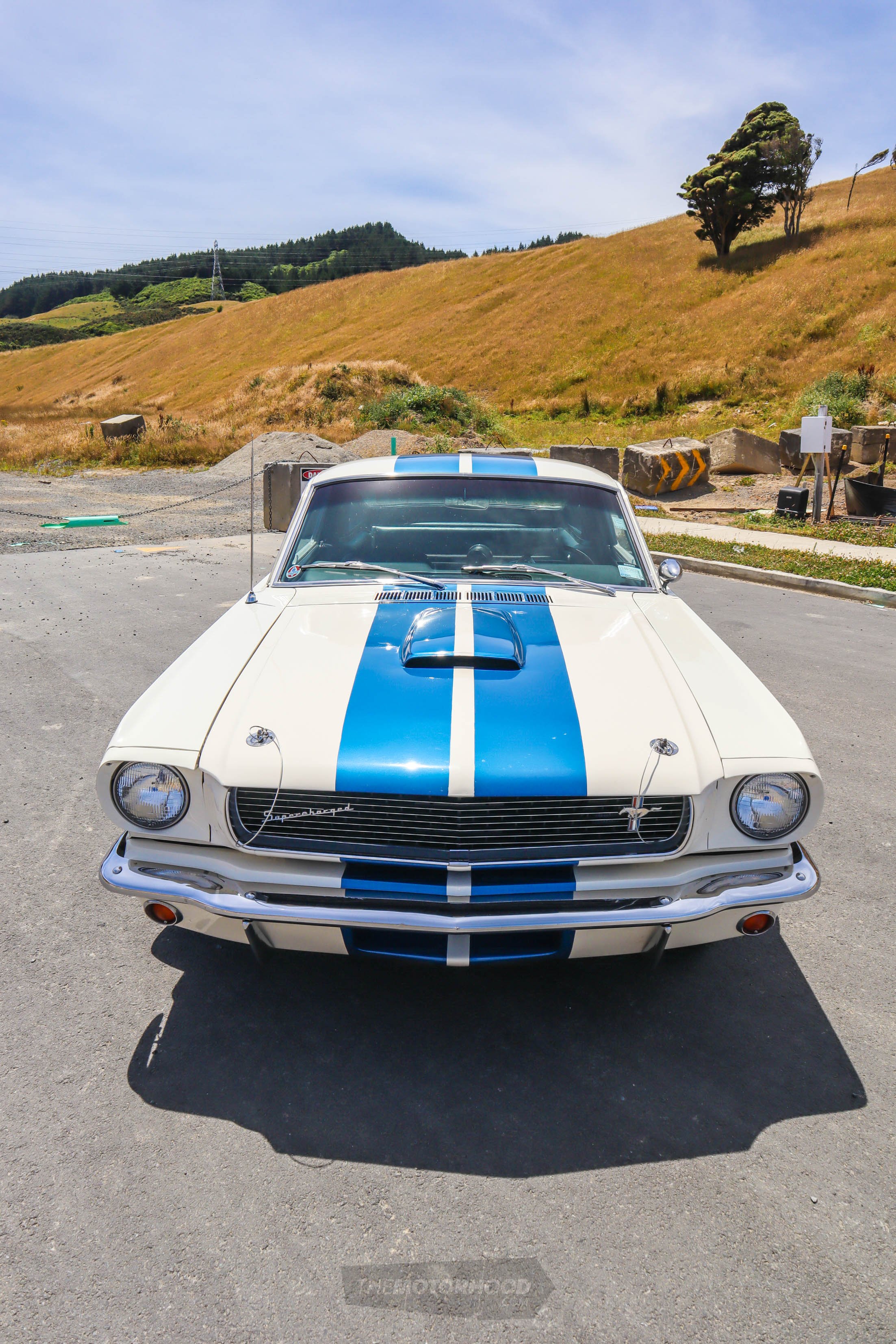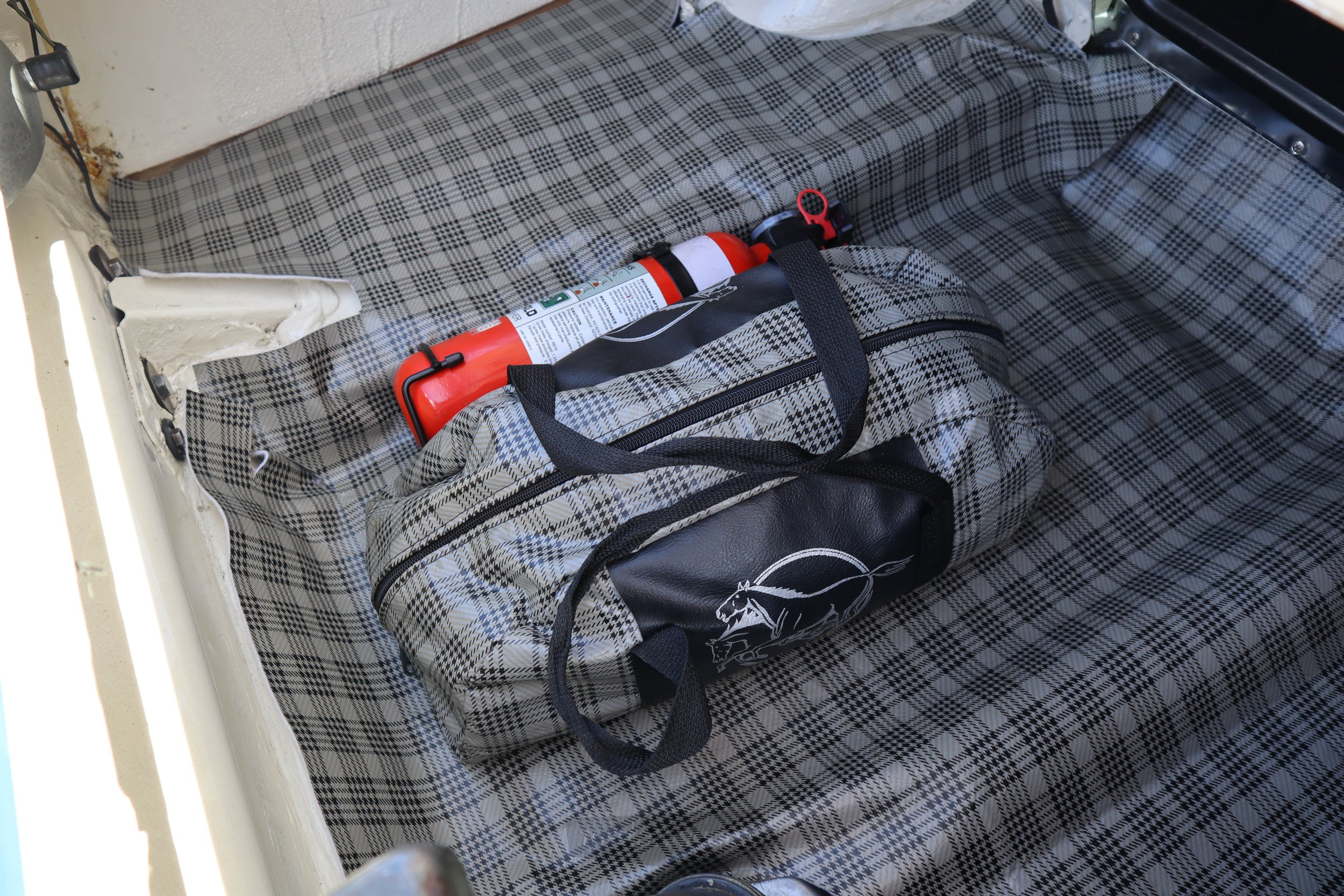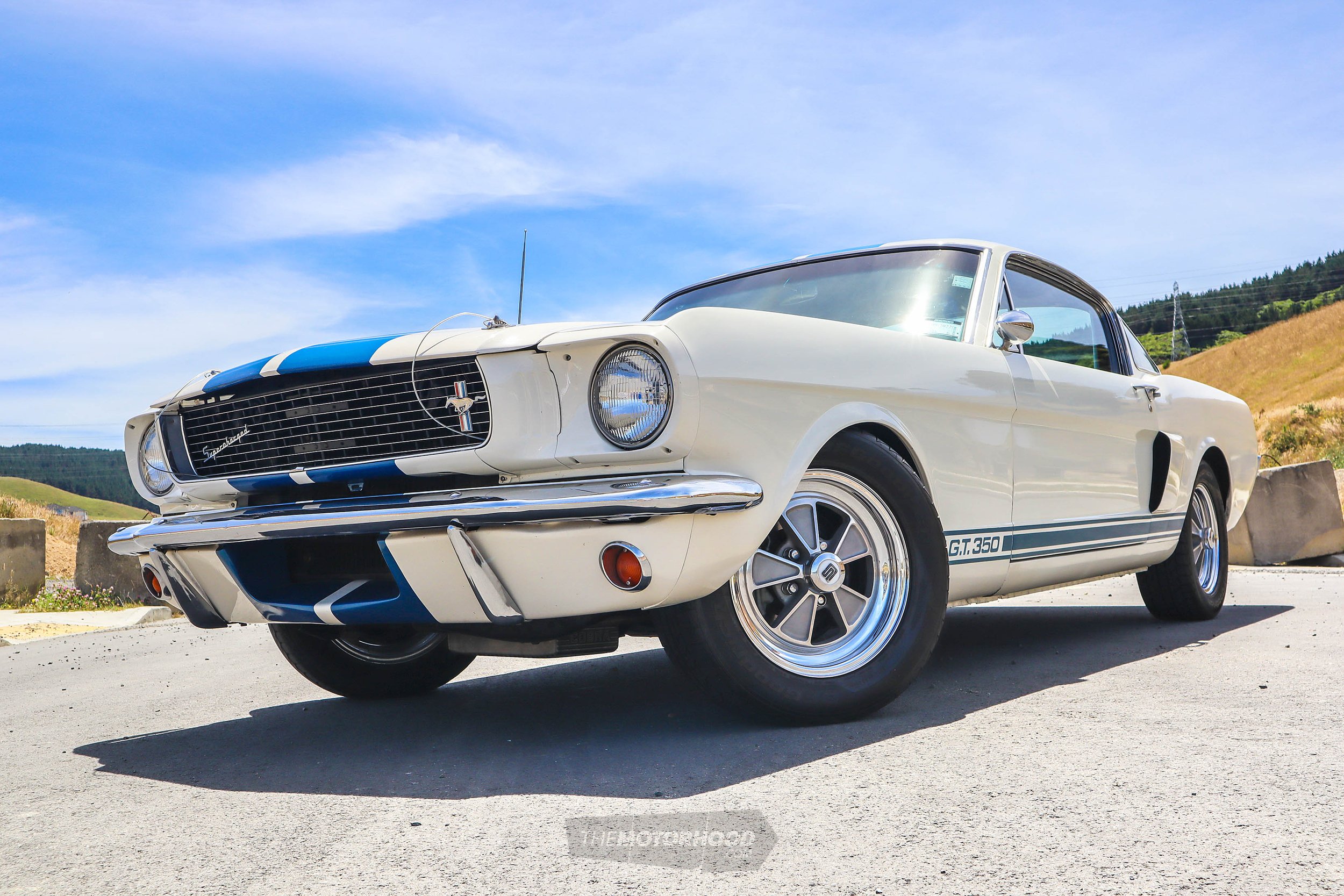A genuine Shelby GT350 is one of the unicorns of the car world but Vaughan Wilson can verify they do exist and can even be found in New Zealand. He has a close encounter with one in Wellington.
By Vaughan Wilson

Unicorns — these mythical creatures have enchanted children and adults alike for centuries. The collective noun for unicorns is a ‘blessing’. Scotland’s national animal is the unicorn, an association that dates back to the 12th century and not, as I imagined, the result of a late-night brainstorming session liberally fuelled by whisky.
Despite their frequent appearance in popular culture unicorns remain famously difficult to spot in the wild. I hadn’t seen one until I was invited into the presence of Malcolm’s original-condition 1966 Shelby GT350 — one of the real unicorns of the car world, alive and well in Wellington.
My only previous sighting had been of one in captivity at the Shelby museum and factory in Las Vegas. This car’s badge of authenticity is its chassis number, 6S349: ‘6’ stands for the year, ‘S’ stands for street version — as opposed to the racing version — and ‘349’ was the original number of this car when birthed. It even has a period-correct Paxton supercharger.
The first Mustang was released on 17 April 1964. The two original body styles were coupé and convertible. The ‘fastback’, as many people call it, was released in August 1964. Ford actually called this body style the ‘2+2’ but the fastback name stuck. Then in 1969 Ford changed the official designation to ‘Sports Roof’ but once more the fastback nickname continued undeterred. In 1964–1966 far fewer fastbacks were sold than the other two body styles, making them the rarest.
In April 1964 the 260-cubic-inch (ci) V8 was designated ‘F-code’. It was soon replaced with the 289ci. In its lowest power form of 20 brake horsepower (bhp) it was known as ‘C-code’. From there, for a few dollars more, you could upgrade to an A-code with 225bhp. Moving up the cost ladder you could order a 271 K-code. In September 2021 Barrett-Jackson sold an ‘as-new’ 1966 K-code fastback for US$100K. The K-code came in all three body shapes and these models are very sought after, having been made in limited numbers.
If you had petrol in your veins, wanted a stick shift, and could afford power equivalent to that of a Corvette then the new Shelby GT350 was in your sights.


A LEGEND IS BORN
Lee Iococca and Ford asked Carroll Shelby to take the fabled Mustang and produce a low-volume version capable of homologation for the B-Production Sports Car Club of America (SCCA) racer.
Initially Shelby built 100 for homologation as ‘street’ cars and 34 customer ‘race’ versions plus two team race cars. The timing was tight from the initial idea in August 1964 to completion in early 1965. Shelby’s team of engineers, mechanics, and test drivers all pitched in — a team that included such luminaries as Peter Brock, Ken Miles, and Chuck Cantwell.
It was reported that Carroll told Lee “a car makes a name; a name doesn’t make a car”. According to legend, to make the point Shelby had one of his shop foremen walk from the corner of the Shelby building at Los Angeles Airport to the property boundary. It took him 347 steps. Shelby rounded that to 350 and the name ‘GT350’ was born. The ‘GT500’ was simply an exaggeration of the original name to denote even more power.
Ford delivered the K-code fastbacks, all in white, from its San Jose factory in Californiato Shelby’s plant in the last week of 1964 and the men went to work — remember they were already busy with the Shelby Cobra and GT40. The new street version of the GT350 retailed at US$4547. The racing version had only a small number of differences from the street version. It had no front bumper, a revised front valance, a roll cage, and could be ordered with different wheels.
The 2800-pound Mustang sold in modest numbers. In total 521 were apparently constructed by August 1965, although numbers vary from source to source. Of these, 34 were racing versions, and at least one had a factory supercharger.
The 1966 GT350 was a softer beast, with better road manners and fewer modifications than the 1965 model. It could also be had in automatic unlike its 1965 predecessor. Ford and Shelby cut a deal with the Hertz Corporation to build 1001 1966 Shelby GT350Hs for the Hertz rental fleet. The cars were rented out for US$17 a day plus 17 cents a mile. The first 85 were manual; thereafter they were automatic. Most were painted in the Hertz colours of black with gold stripes but they did come in other colour and stripe combinations.

RACE ON SUNDAY, RETURN ON MONDAY
These GT350Hs were often rented by wannabe racers who would drive them hard and take them back raced, rallied, and sometimes rolled. On more than one occasion evidence that a roll cage had been installed during the rental period told its own story. During 1966 more versions were also sold to the public, with around 1373 fastbacks and four convertibles — used as prototypes — making a grand total of 2378 GT350s. Differences included no race version, a high-performance C4 three-speed automatic gearbox as an option, and varying colours (black, red, green, and blue) including the Hertz versions. Sources also disagree slightly on total production for 1966.
To save weight the 1965 version had no back seat. A fold-down item was added for 1966 along with bespoke rear quarter windows to replace the conventional Mustang fastback’s vent assemblies. The 1966 model also had functional quarter-panel scoops for brake cooling on the rear wheels.
The first 252 1966 GT350s used the 1965 chassis and as such are known to collectors as ‘carry over’ or ‘left over’ Shelbys. They are seen as the most desirable of the 1966 GT350s. There were various options available over 1965 and 1966, and all were manual, so they are often unique.



To improve manufacturing times and reduce costs other things were changed from 1965 to 1966. The loud side-exhaust pipes were changed to the regular K-code rear-exiting pipes. The override traction bars were replaced with underride traction bars as these cost less to make and install. The hood was fibreglass in 1965 but steel and a part steel / part fibreglass version was used in 1966. The wooden steering wheel was replaced with a plastic wood-effect version. Finally, the wheels offered were 14 inches with several other wheel designs offered as options at a cost.
The power of the 1965 and the 1966 GT350s was identical for the street version — no race version was available in 1966. The performance of the 1966 was slightly different, however, varied by its slight extra weight increase and lesser suspension modifications. The standard K-code 271 horsepower (hp) was increased nder the Shelby upgrades to 306hp using an aluminium high-rise intake manifold, a Holley four-barrel carburettor, Tri-Y headers, and a glasspack dual exhaust.
With 329 foot-pound of torque it could reach 60mph in 6.5 seconds, topping out at 126mph — a reasonable time in 1965. Remember the muscle car wars had not really started yet. Although the Pontiac GTO had been released the year before, the GT350 was still using what, for then, was a modest-sized engine and the original block from the standard car. It was the GT500 that would see much larger engines shoehorned into the modest-sized two-door.

PAXTON’S PUFFER
The Paxton supercharger added around 89hp. There are no official times; in any case the car’s performance was constrained by its gearbox. According to legend Paxton’s Joe Granatelli demonstrated to Shelby the capability of the supercharger in a GT350 against a lighter 289 Shelby Cobra. The GT350 won. In 1966 only 11 Shelby GT350s had the supercharger and it was installed only on customer request. Many more were installed later by dealers using the same Paxton equipment. The Shelby American Automobile Club estimated this to have been done to between 50 and 100 of the 1966-model GT350s.
Malcolm Macrae is the lucky unicorn hunter who owns our featured 1966 GT350. Malcolm also owns a 2013 Mustang GT. In the past he has owned a 1968 GT350, a 2010 Shelby GT500, and numerous other Mustangs. He saw his first Mustang as a lad when his uncle brought one in from the States and has been smitten ever since. Now that he is on the other side of 50 Malcolm can be satisfied he has a daily driver and a weekend marauder.
Malcolm’s car is in amazing condition. It is not concours but a real survivor — the unicorn of many people’s dreams. As far as Malcolm is aware the car has never been repainted although some panels have been retouched or repainted at different times as circumstances have required. The interior, under the bonnet, and just about everywhere else are very much in perfect to near-perfect condition, and the look of that supercharger in the engine bay, with the bolder-than-brass ‘Supercharged’ wording — in 1960s font — across the grille, is far from shy.
Malcolm thinks the car had eight owners in the States, with a lengthy stay in storage from 1971 — hence its condition and low miles. Craig Conley, who owns Paradise Wheels in the US, bought the car in the mid ’90s. Paradise Wheels sells new versions of 1960s Shelby wheels and Craig is an expert on 1960s Shelbys and Paxton superchargers. He installed the original equipment manufacturer (OEM) unit on this Shelby. Craig has the largest collection of spare parts for Paxton superchargers in the world.
In 1994 this car appeared in Super Ford magazine. The article referred to Craig taking it down the drag strip, with a time of 13.81s at 106.13mph.


EXOTIC SPECIES
The Shelby came to our shores in 2003. It went from the original New Zealand owner to an owner in Auckland. Malcolm just happened to be in the right place with the right amount of money in 2018 and a deal was done. Since then plenty of people have tried to buy it off him. The odometer reads 92,300 miles. From the condition of the car that seems to be correct and only the first time around.
Malcolm’s car is an automatic. It has the 1966 dashboard, the back seat, the rear quarter windows, and the scoops funnelling air to the rear brakes. Malcolm pointed out the part steel and part fibreglass bonnet. He even has the original bill of sale from October 1965 in California.
Malcolm let me drive his precious car but not before telling me it is a handful. The steering is heavy and unassisted but otherwise it is very drivable and keeps up with modern traffic. The engine generates some noise, especially when the go pedal is pushed but its road manners are more than manageable. The brakes are old school and one needs to drive accordingly. It truly is a wonder.
I own a 2011 GT500 but that is effectively a fast and responsive Mustang, as you’d expect from a modern carmaker. In comparison this car is raw. It was built by Shelby and his staff in a small factory using their specific knowledge and techniques. The car is a time machine and I was transported back to 1966. The car corners much better than a standard 1966 Mustang but a long trip would be quite uncomfortable. You feel the road and its bumps, which just makes the grin on your face all the broader.
So here’s proof that unicorns, albeit in the form of the legendary 1966 Shelby GT350 pony car, do exist. There was only one of them to be seen but it was still a blessing.

This article originally appeared in NZCC issue No. 376


